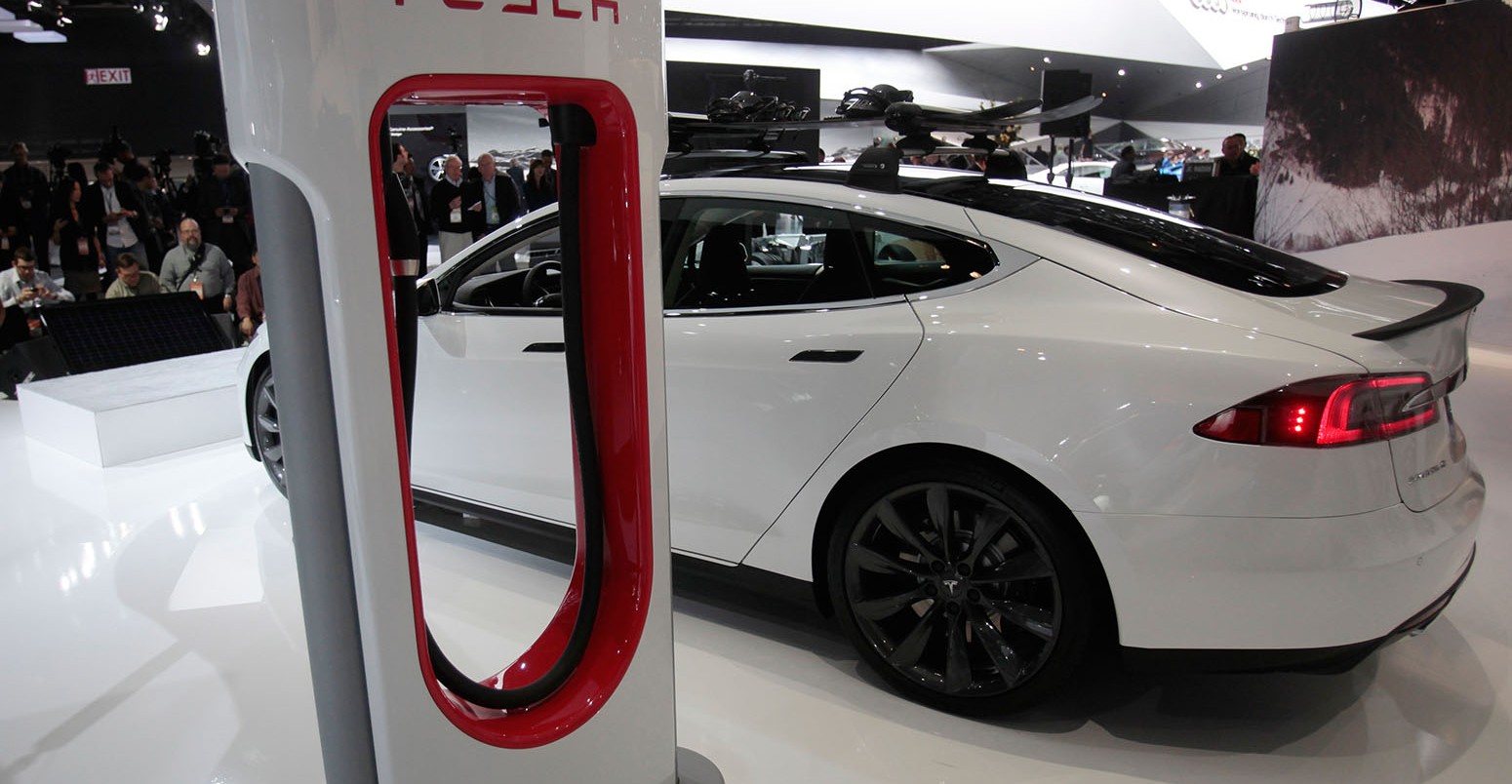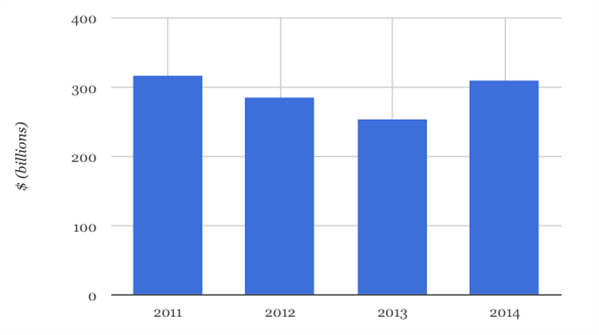
The rise, fall and future of the cleantech industry
Sophie Yeo
09.10.15In the climate change toolbox, “clean technology” is the component that spans high excitement (think Elon Musk’s Tesla cars) and the deeply mundane (think frequency converters, waste heat recovery boilers, and more).
While there is no single accepted definition, the phrase spans technologies that cut emissions, improve the environment, and reduce the consumption of natural resources.
The development of clean technology is touted as one of the most effective ways to tackle climate change and other environmental issues.
And it is already a multibillion-dollar business. According to figures from consultancy firm Frost & Sullivan presented at the Global Cleantech Summit in Helsinki this week, the market for clean technology was worth $601bn in 2014. By 2020, the firm predicts this will expand to $1.3tn.
With the world likely to sign an emissions-cutting deal in Paris in December this year, and large economies such as India and China eager for ways to clean up their air pollution, rivers and land, it is easy to paint the future of the clean technology in a rosy light.
Speaking in Helsinki on Tuesday, Achim Steiner, executive director of the United Nations Environment Programme (UNEP), said:
“Clean technology is succeeding today not only in Europe but all over the world. China is one of the largest producers of renewable energy today. India has just announced a 100,000MW solar programme. Saudi Arabia is on the forefront. Kenya, the country in which we operate, because of its green energy policy put in place eight years ago, is today producing the vast majority of its electricity with renewables…The story repeats itself, in the United States, in South America.”
Slump
However, the story is not an entirely happy one. In 2012 and 2013, investments in clean technology slumped.
Figures released in January 2014 by Bloomberg New Energy Finance showed that, after a record $318bn in global investment in clean energy in 2011, this dropped to $286bn in 2012 and again to $254bn in 2013.
This, too, was a story that repeated itself across the globe. In 2013, China saw its investments in clean energy slip by 3.8% from 2012 levels, down to $61bn. In the US, investments dropped by 8.4% to $48bn.
Europe saw one of the biggest declines, with investment falling by 41% down to $58bn in 2013. Bloomberg attributed this to big economies, such as Germany, Italy and France, restricting subsidy payments for new projects and failing to dispel uncertainty over future support.
Wind, solar and biomass all saw investments drop during this period – although for other clean technologies, including smart grids, storage, electric vehicles and efficiency, investments continued to rise slightly.
The decline in investments was unwelcome news in the industry, but Bloomberg stressed that it did not tell the whole story. Part of the reason for the crash in Europe was because of the falling cost of solar installations, for instance, whose volume grew by around 20% worldwide in 2013, regardless of falling investments.
And by 2014, investments in the world of clean technology were back on track. In January this year, Bloomberg reported its latest figures – a 16% surge on 2013 levels to $310bn. It attributed the increase partly to demand for large-scale and rooftop solar installations, improved competitiveness, and record financing for offshore wind projects.
The rise and fall of cleantech investments 2011-2014. Figures from Bloomberg New Energy Finance, chart by Carbon Brief
Cleantech around the world
Those are the figures, but how are developments in clean technology playing out practically around the world?
Hashim Yamani is the president of Saudi Arabia’s King Abdullah City for Atomic & Renewable Energy, the organisation established by royal decree in 2010 to develop alternative energy sources for what is one of the world’s largest petrostates.
In Helsinki, he pointed out the difficulties of generalising when it comes to clean technology. He said:
“The misplaced scepticism about the bright future of cleantech results from two sources. First, clean tech is not really a well-defined coherent industry, but rather a toolbox of diverse technologies, united by the fact that they respond to the challenge of realising a clean future. Yet, each technology has its own development and adoption history, distinct from those of the other technologies, to the point that drawing definitive general conclusions about cleantech is at best debatable and is often incorrect.”
Context is everything, he stressed – and many were ready to highlight the positive role that clean technology was playing in their own country or region, as well as emerging opportunities.
Asked by Carbon Brief for the best example of clean technology innovation in his country at the moment, Gediminas Onaitis, vice minister of the economy in Lithuania, said:
“One of the best examples is our biomass heating sector. We have district heating in almost all regions, at least in the bigger regions, and we almost replaced all gas boilers to biomass boilers, and the interesting thing is we get a double result all at once, maybe even a triple result: we get greener energy, we made the price cheaper for the consumer, which is interesting because greener is not always cheaper, and the third thing is the production of fuel is located in the EU or even in Lithuania instead of the eastern countries.”
Achim Steiner, who is based in Nairobi, Kenya, as head of UNEP, highlighted his own observations about the opportunities for more collaboration between Africans and China. He said:
“For the last few years, China has enabled many Africans to gain access to mobility by being able to buy very cheap, two stroke engine motorcycles. From an air pollution point of view, two stroke engine motorcycles are more polluting than any other model that we have on the streets today. China has at the same time in its own economy developed electric motorcycle technology of which is has sold over 200 million by now in the domestic market. It has the same cost as a two-stroke engine, and here the question arises from an economy such as Kenya or Africa, or many other developing countries: why should electric cycle mobility not become an integral part of the mobility market at least in the urban centres in Africa?”
Olli Rehn, Finland’s minister of economic affairs, described how the government was helping clean tech start-ups to get off the ground. He said:
“A recent survey by the Finnish Confederation of Industries found that we have more than 3,000 cleantech companies. That is a big number of companies for a small country like Finland. The government has shown consistent and considerable commitment to clean tech. Just a week ago, the government announced an extra investment of â?¬300m into clean tech and the bioeconomy.”
Meanwhile, there are developments taking place that would not necessarily be considered under the clean tech umbrella that are nonetheless helping to make the world a lower carbon planet. Anil K. Gupta of the University of Maryland highlights Uber, the latest trend in taxis. He says:
“Uber in India, they’re talking about investing between $1-2bn more in the next couple of years. They’re going to invest $2bn in China. And Uber is neither the number one player in India, nor in China. Their local competitors are as strong, and they’re investing billions of dollars. The Uber phenomenon in India is now going not just at the level of cars, but at the level of motorbikes and three wheelers and so on. So we have to see what is the impact of these technologies in terms of the efficiency with which things happen.”
Massoumeh Ebtekar, vice president of Iran, added that the 5+1 negotiations over Iran’s nuclear programme could help to open up a new era for cleantech in the country. She said:
“The post-sanctions era is a very important era for Iran and one of the areas where we are looking forward to investments and also exchanges is the area of clean technologies.”
Barriers
Nonetheless, despite a host of positive examples from both developed and developing countries, the barricades of the cleantech revolution have yet to fall.
There are a number of barriers, including government regulations, market distortions, lack of finance and opposing interests.
When it comes to clean technology, there is both the demand and the funding, but the difficulty comes in matching these up, Lithuania’s vice economy minister tells Carbon Brief:
“The demand really exists, for energy efficiency, for renewable energy and so on. At the same time, there is existing funding for that from governments, and also the funding from the private sector…But the interesting point is that, for some reason, from year to year we cannot find the right connections between that request and between the initiative to invest in that sphere.”
Finland’s Rehn says that the role of policymakers is clear: cleantech needs to be given the same opportunities afforded to older, fossil-fuel based technologies in order to succeed. According to a recent investigation by the International Monetary Fund (IMF), the fossil fuel industry will benefit from subsidies worth $5.3tn in 2015, equivalent to $10m a minute every day. Rehn said:
“Like in football or any other sport, if the rules of the game are not fair, even the best team cannot win. This also goes for cleantech. We need fair rules. With fair rules, it is the best team that can win. Unfortunately, the rules of the cleantech game are not yet fair.”
Jukka Uosukainen leads the Climate Technology Center and Network, established under the UN to help developing countries to access the technology they need to cut their emissions and adapt to climate change. He said:
“It’s about regulation, it’s about standards. If we work on that kind of basis, where new technologies have got equal opportunities with the older fossil based ones, at least we are in the game. That’s why the role of governments are so important.”
Returning to the IMF’s subsidy study, part of the total came from indirect costs that reflect the health and environmental impacts of burning fossil fuels. UNEP’s Steiner says part of the challenge is about correcting the impression that green products are ultimately the more expensive:
“The debates of the 80s and 90s in Europe, that green products are too expensive and people will not buy them, is very true. Why would a household that just about manages to cope with its monthly income suddenly spend 20 or 30% more for a cleantech product on the shelves of the supermarket if there’s a product right next to it that gives you the same service for a third less of the cost? The problem is this issue of externalities. This less efficient product is cheaper, but the cost is ultimately borne by the taxpayer and citizens at last. Here, the internalisation of these costs becomes a critical part of correcting a distorted market.”
Conclusion
The rise, fall and rise of clean technology will be one of the foundation stones on which the UN climate talks in Paris commence this December.
Without the assurance that the clean energy, electric cars and other products exist to help them clean up their economies and environments, countries will be unwilling to sign up to ambitious targets to reduce their emissions.
But while the need is there, this will not happen by itself. The clean technology industry requires finance, regulation and belief to make it happen. As Steiner says:
“Take a closer look at the imperatives for change that we now face, for energy, food, water, resources, land, and you very quickly see that our economies will go through an enormous amount of transformation.
“Whether by design or by default, that is probably the moment in time we are currently facing.”
Image: A Tesla S electric car and a charging station at the North American International Auto Show in Detroit. Credit: © REBECCA COOK/Reuters/Corbis.
-
@CarbonBrief analyses the rise, fall and future of the cleantech industry


